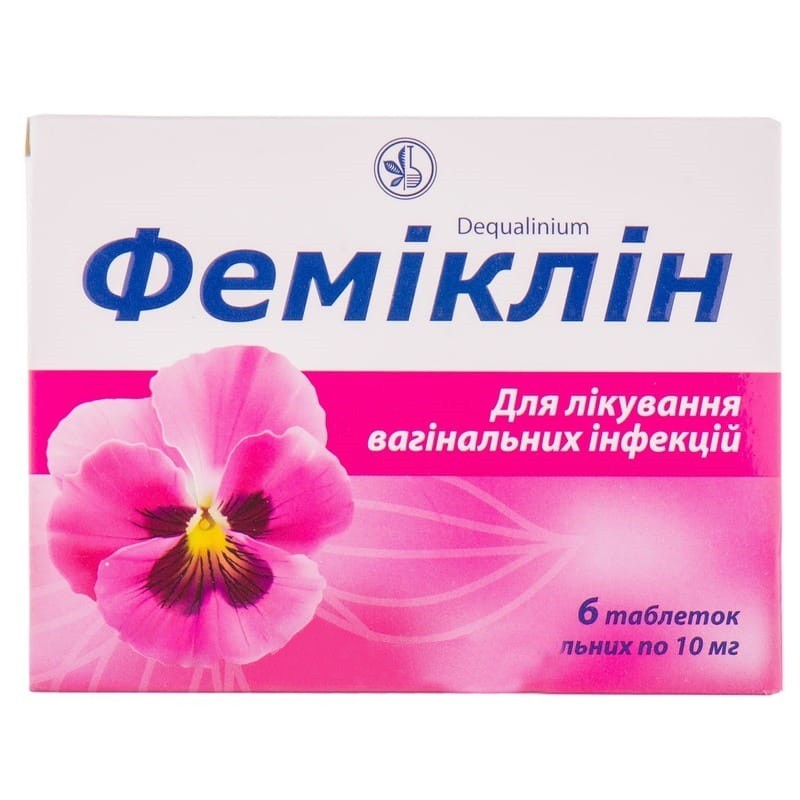



 Secure and encrypted payment processing
Secure and encrypted payment processing We ship to over 40 countries including the USA, UK, Europe, Australia and Japan
We ship to over 40 countries including the USA, UK, Europe, Australia and Japan Guaranteed refund or reship if you haven't received your order
Guaranteed refund or reship if you haven't received your orderActive substance: dequalinium chloride;
1 vaginal tablet contains 10 mg of dequalinium chloride;
excipients: lactose, monohydrate; microcrystalline cellulose; magnesium stearate.
Vaginal tablets.
Basic physical and chemical properties: oblong-shaped tablets, with a biconvex surface, white or almost white.
Antimicrobial and antiseptic agents used in gynecology, with the exception of combinations with corticosteroids. quinoline derivatives. Dequalin.
ATX code G01A C05.
Pharmacodynamics
Femiclin contains dequalinium chloride, a quaternary ammonium compound with a wide spectrum of antimicrobial activity against various gram-positive and gram-negative bacteria, fungi, and protozoa unicellular organisms (Trichomonas vaginalis). The activity of dequalinium chloride in vitro was established against the microorganisms that are significant for the vaginal site. This activity is expressed as the minimum inhibitory concentration (MIC).
| MIC (mg / L) | MIC (mg / L) | ||
| Gram-positive bacteria | Gram-negative bacteria | ||
| Streptococci group B | 2 – 8 | Fusobacteria | 32 – 64 |
| Staphylococcus aureus | 0,2 – 10 | Gardnerella vaginalis | 2,0 – 256 |
| Streptococci Group A | 0,25 – 20 | E. coli | 1 – 400 |
| Listeria sp. | 4 – 32 | Serratia sp. | 3,1 – 400 |
| Peptostreptococci | 1 – 32 | Klebsiella sp. | 3,1 – 400 |
| Streptococci group D | 0,2 – 64 | Pseudomonas sp. | 5 – 400 |
| Mushrooms | Bacteroides sp./Prevotella sp. | 64 – 512 | |
| Candida tropicalis | 0,2 – 50 | Proteus sp. | 20 — 1024 |
| Candida albicans | 0,2 – 200 | The simplest unicellular organisms | |
| Candida glabrata | 0,2 – 256 | Trichomonas vaginalis | 28,8 – 400 |
| Candy krusei | 128 | ||
After dissolving a vaginal tablet, Femiclin (10 mg of dequalinium chloride) in approximately 2.5–5 ml of vaginal fluid, the concentration of dequalinium chloride in it is 4000–2000 mg / l, which is higher than MIC90 for all pathogenic microorganisms tested. No development of microorganism resistance to dequalin chloride has been reported. As with other surfactants, the main mechanism of action of dequalinium chloride is based on increased cell permeability and subsequent loss of enzyme activity, which leads to cell death. Dequalinium chloride in vaginal tablets exerts its action locally in the vagina. A noticeable decrease in secretions and inflammation usually occurs after 24–72 hours.
Pharmacokinetics
Since vaginal absorption is negligible, there is no data on the pharmacokinetics of dequalinium chloride in humans.
Interactions with other drugs are unknown.
If necessary, the simultaneous use of any medications should consult with your doctor.
Femiclin is incompatible with soap and other anionic surfactants.